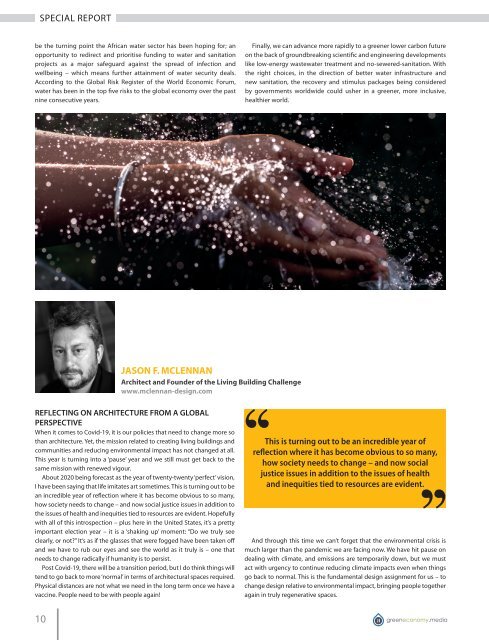Green Economy Journal Issue 41
You also want an ePaper? Increase the reach of your titles
YUMPU automatically turns print PDFs into web optimized ePapers that Google loves.
SPECIAL REPORT<br />
be the turning point the African water sector has been hoping for; an<br />
opportunity to redirect and prioritise funding to water and sanitation<br />
projects as a major safeguard against the spread of infection and<br />
wellbeing – which means further attainment of water security deals.<br />
According to the Global Risk Register of the World Economic Forum,<br />
water has been in the top five risks to the global economy over the past<br />
nine consecutive years.<br />
Finally, we can advance more rapidly to a greener lower carbon future<br />
on the back of groundbreaking scientific and engineering developments<br />
like low-energy wastewater treatment and no-sewered-sanitation. With<br />
the right choices, in the direction of better water infrastructure and<br />
new sanitation, the recovery and stimulus packages being considered<br />
by governments worldwide could usher in a greener, more inclusive,<br />
healthier world.<br />
Jason F. McLennan<br />
Architect and Founder of the Living Building Challenge<br />
www.mclennan-design.com<br />
REFLECTING ON ARCHITECTURE FROM A GLOBAL<br />
PERSPECTIVE<br />
When it comes to Covid-19, it is our policies that need to change more so<br />
than architecture. Yet, the mission related to creating living buildings and<br />
communities and reducing environmental impact has not changed at all.<br />
This year is turning into a ‘pause’ year and we still must get back to the<br />
same mission with renewed vigour.<br />
About 2020 being forecast as the year of twenty-twenty ‘perfect’ vision,<br />
I have been saying that life imitates art sometimes. This is turning out to be<br />
an incredible year of reflection where it has become obvious to so many,<br />
how society needs to change – and now social justice issues in addition to<br />
the issues of health and inequities tied to resources are evident. Hopefully<br />
with all of this introspection – plus here in the United States, it’s a pretty<br />
important election year – it is a ‘shaking up’ moment: “Do we truly see<br />
clearly, or not?” It’s as if the glasses that were fogged have been taken off<br />
and we have to rub our eyes and see the world as it truly is – one that<br />
needs to change radically if humanity is to persist.<br />
Post Covid-19, there will be a transition period, but I do think things will<br />
tend to go back to more ‘normal’ in terms of architectural spaces required.<br />
Physical distances are not what we need in the long term once we have a<br />
vaccine. People need to be with people again!<br />
This is turning out to be an incredible year of<br />
reflection where it has become obvious to so many,<br />
how society needs to change – and now social<br />
justice issues in addition to the issues of health<br />
and inequities tied to resources are evident.<br />
And through this time we can’t forget that the environmental crisis is<br />
much larger than the pandemic we are facing now. We have hit pause on<br />
dealing with climate, and emissions are temporarily down, but we must<br />
act with urgency to continue reducing climate impacts even when things<br />
go back to normal. This is the fundamental design assignment for us – to<br />
change design relative to environmental impact, bringing people together<br />
again in truly regenerative spaces.<br />
10 greeneconomy.media


















